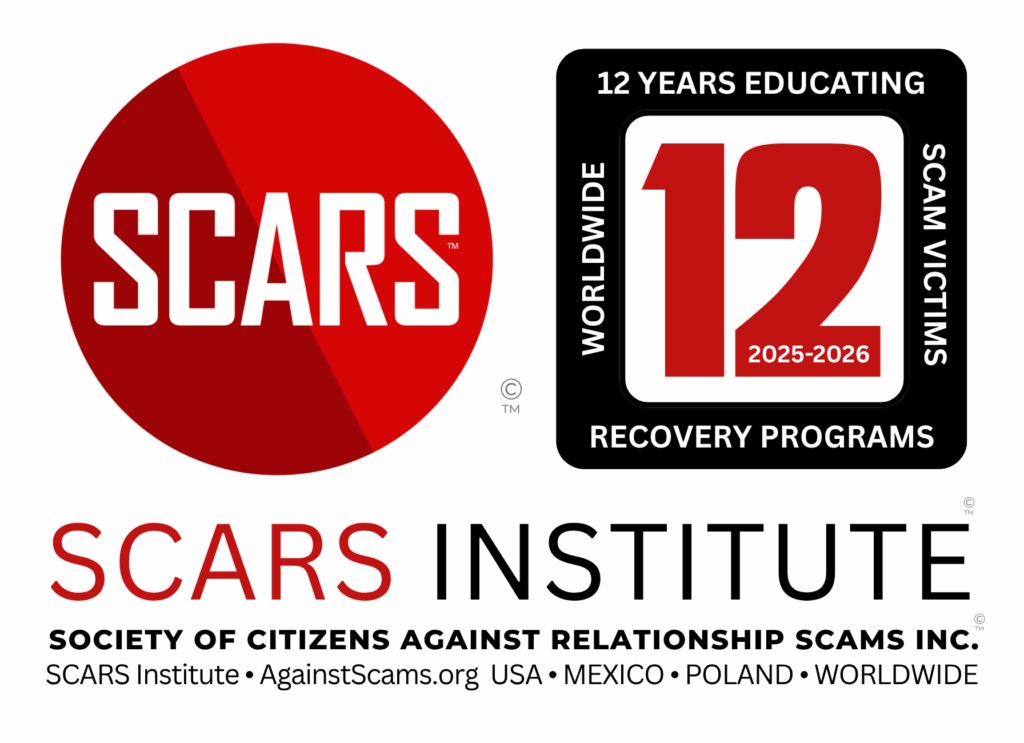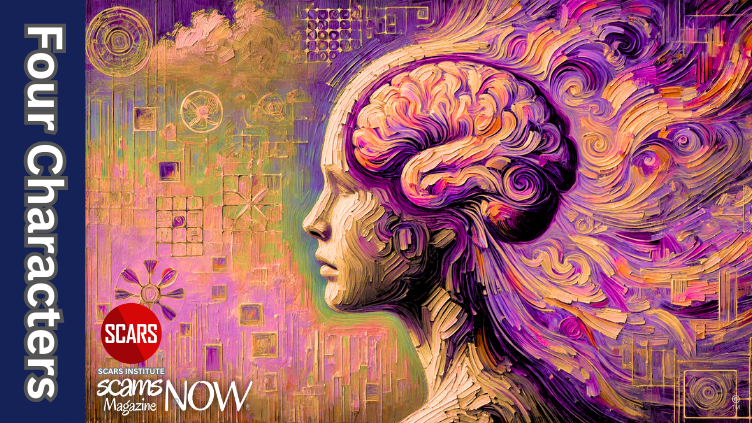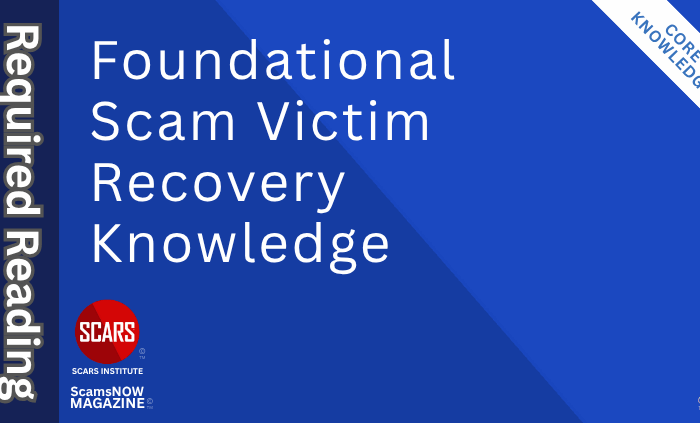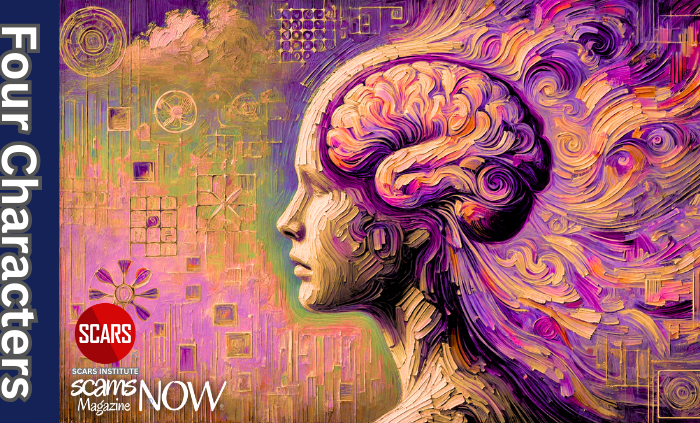Symbols in Our Minds – Icons, Symbols, and Logos Trigger Automatic Responses in Scam Victims
The Symbols of our Time: Symbols, Icons, and Logos Have a Deep Connection with our Minds Especially Important for Scam Victims
Primary Category: Psychology of Scams
Author:
• Tim McGuinness, Ph.D., DFin, MCPO, MAnth – Anthropologist, Scientist, Polymath, Director of the Society of Citizens Against Relationship Scams Inc.
About This Article
Understanding symbols and their use in the context of scams is crucial for scam victims because it can reveal the psychological strategies that scammers employ to manipulate trust and exploit emotions. Symbols, logos, and icons are powerful visual cues that influence how the brain processes information, often bypassing logical thinking to trigger instinctual or emotional responses.
Scammers leverage this by mimicking trusted symbols from legitimate institutions, using familiar logos, security badges, or even simple color choices to make their schemes appear credible and urgent.
For victims, recognizing these visual manipulations can help them critically assess the legitimacy of emails, websites, and documents, thereby reducing susceptibility to fraud.
Educating scam victims on how these symbols function to manipulate trust and create a sense of urgency empowers them to approach potentially fraudulent content with caution, making them less likely to fall for emotional or authority-based traps. This knowledge is essential for scam victims’ recovery and prevention, equipping them with the tools needed to navigate a visually deceptive world.

The Symbols of our Time: Symbols, Icons, and Logos Have a Deep Connection with our Minds – Especially Important for Scam Victims
Icons, symbols, and logos hold a unique power to influence our minds because they are processed differently in the brain than words. The brain’s visual system is highly attuned to processing images and patterns quickly and instinctively, enabling symbols to convey meaning in a fraction of a second. When we encounter a symbol, the visual cortex recognizes its shape, color, and context, which is then interpreted through associative pathways that connect it with memories, emotions, and cultural significance.
In particular, symbols activate the brain’s limbic system, which is involved in emotional processing. For example, the Nike “swoosh” or McDonald’s golden arches may evoke feelings of excitement, trust, or nostalgia due to repeated exposure and association with specific experiences or societal values. This phenomenon is known as “semantic memory,” where symbols trigger learned associations that generate instant emotional responses. Familiar logos bypass rational thought and engage the brain’s “reward system” through dopamine release, especially when connected with positive memories.
Furthermore, symbols are processed by the brain’s “fusiform gyrus,” an area responsible for recognizing familiar objects and faces, helping logos become instantly recognizable. This capacity for rapid recognition taps into the brain’s tendency toward cognitive shortcuts, allowing us to process complex ideas through simple images. Because symbols compress meaning into visuals, they also reduce cognitive load, which can influence behavior and decisions without conscious thought. This is why symbols are so effectively used in branding, politics, and even safety signage.
In essence, symbols and logos operate on a psychological level, allowing businesses, organizations, and cultures to communicate quickly and deeply, shaping beliefs, loyalty, and actions without requiring verbal communication. This understanding underscores the importance of intentional design and the powerful, often unconscious influence symbols can wield in daily life.
The Study of Symbols
The study of symbols is called semiotics, or semiology:
Definition
Semiotics is the study of how meaning is created through signs, symbols, and signification. It focuses on how people create and interpret the meaning of signs and symbols, including how people visually communicate through metaphor, analogy, allegory, metonymy, and symbolism.
Semiotics, or semiology, is the study of signs, symbols, and signification.
It is the study of how meaning is created, not what it is. Below are some brief definitions of semiotic terms, beginning with the smallest unit of meaning and proceeding towards the larger and more complex:
-
- Signifier: any material thing that signifies, e.g., words on a page, a facial expression, an image.
- Signified: the concept that a signifier refers to.
Together, the signifier and signified make up the
-
- Sign: the smallest unit of meaning. Anything that can be used to communicate (or to tell a lie).
- Symbolic (arbitrary) signs: signs where the relation between signifier and signified is purely conventional and culturally specific, e.g., most words.
- Iconic signs: signs where the signifier resembles the signified, e.g., a picture.
- Indexical Signs: signs where the signifier is caused by the signified, e.g., smoke signifies fire.
- Denotation: the most basic or literal meaning of a sign, e.g., the word “rose” signifies a particular kind of flower.
- Connotation: the secondary, cultural meanings of signs; or “signifying signs,” signs that are used as signifiers for a secondary meaning, e.g., the word “rose” signifies passion.
- Metonymy: a kind of connotation where in one sign is substituted for another with which it is closely associated, as in the use of Washington for the United States government or of the sword for military power.
- Synecdoche: a kind of connotation in which a part is used for the whole (as hand for sailor).
Hard-Wired Symbols in our Brains
certain symbols and shapes appear to be “hard-wired” in the human brain and evoke instinctive responses across cultures. These symbols tap into the brain’s evolutionary and psychological foundations, often related to survival, social cohesion, and threat detection. Here are some of the most universally recognized symbols:
The Face and Eye Shapes
The human brain is highly sensitive to faces and eye-like shapes, which are crucial for social interaction. This sensitivity is rooted in the brain’s fusiform face area, specialized in facial recognition. Eyes, especially when depicted as gazing directly, can invoke a range of emotions from comfort to threat, depending on the context. Research has shown that even infants respond to eye-like symbols, suggesting a deep-seated recognition system.
Circles and Curves
Circular shapes tend to be perceived as non-threatening and evoke a sense of calm or unity. Psychologically, round objects are associated with gentleness and safety, whereas angular shapes can signal danger or aggressiveness. This preference is thought to stem from survival instincts, as round or smooth objects in nature are rarely threatening, whereas sharp edges could indicate danger.
Triangles and Sharp Edges
Conversely, triangular shapes and sharp edges often signal caution or threat, activating parts of the brain associated with vigilance. Triangles are frequently used in warning signs and caution symbols because they naturally draw attention. This response is considered part of the “primal brain” as sharp objects historically posed physical threats, leading to an instinctual alertness.
Patterns of High Contrast
Patterns such as stripes or checkerboards, particularly in high-contrast colors like black and white, are attention-grabbing and evoke caution. Known as “warning coloration” in nature (like the stripes of a venomous snake), humans interpret high-contrast patterns as potentially dangerous, which triggers the brain’s amygdala responsible for emotional responses like fear.
Crosses and Symmetrical Patterns
Crosses and symmetrical shapes are common in religious and cultural symbols worldwide, likely because they represent balance and stability. The symmetry in these shapes is processed by the brain as harmonious and orderly, often evoking feelings of peace and security.
Fire and Light
Bright, warm colors, and patterns mimicking fire or sunlight, instinctively draw attention due to their association with warmth, survival, and life-giving energy. Firelight has historically been essential for survival, so the human brain is naturally inclined to focus on and interpret bright lights as positive, familiar signals.
Spirals
Spirals are powerful and ancient symbols, appearing in nature and across cultures in artwork, religious motifs, and architecture. This shape often represents growth, expansion, and transformation due to its association with natural forms like galaxies, shells, and whirlpools. Spirals are deeply embedded in the human psyche and may be hard-wired due to their frequent appearance in the natural world and connection to life-sustaining processes.
In the brain, spirals are often processed as dynamic shapes that seem to move, drawing the viewer’s eye inward or outward. This movement can trigger curiosity, as the brain interprets spirals as representing a journey or cycle. Psychologically, spirals also evoke calm and mystery; they represent movement without aggression or threat. Culturally, many societies link spirals to spiritual or existential ideas, from Celtic spirals symbolizing the journey of life, death, and rebirth to the Fibonacci spiral in Greek and Roman art as an expression of harmony and beauty.
The appeal of the spiral may be partially explained by the brain’s tendency toward pattern recognition and preference for forms found in nature. In cognitive processing, the gradual flow and balance in a spiral stimulate the brain without causing stress, unlike more angular shapes. Spirals naturally engage the brain’s visual processing centers, helping to focus attention and providing a sense of continuity and calm, potentially explaining why they are often used in therapeutic art and mandalas.
Spirals remain one of the most universal and complex symbols, affecting us on visual, emotional, and subconscious levels, showing how even basic shapes can carry deep meaning rooted in both biology and culture.
These symbols resonate across cultures and eras, partly because they tap into universal survival mechanisms and partly due to shared human experiences. They demonstrate how some shapes and patterns are neurologically wired to trigger specific responses, influencing how we interpret and react to visual cues on both a conscious and subconscious level.
Symbols or Icons Can be Used to Control Behavior
Symbols and icons that can influence or control behavior are often those that tap into deeply rooted psychological or cultural associations. Here are a few types of symbols and icons that can have a strong impact on human behavior:
Stop Signs and Red Indicators
-
- Color and Shape: Red is widely recognized as a color that signals alert or danger due to its association with blood and fire, which are universally linked to threat. The octagonal stop sign shape is instantly recognizable and signals drivers or pedestrians to halt, even without words.
- Psychological Impact: The brain processes red as a warning or directive, often causing immediate compliance or caution. Studies suggest that red signs capture attention faster than other colors and increase reaction speed, which is why red is used in everything from traffic signals to warnings on dangerous substances.
Arrows and Directional Symbols
-
- Shape and Movement: Arrows naturally imply movement, guiding the viewer’s gaze or actions toward a specific direction. They are often used in wayfinding and design to direct behavior without words.
- Cognitive Processing: The brain is naturally inclined to follow an arrow’s path, associating it with direction and intent. In airports, malls, or websites, arrows help users navigate spaces or interfaces intuitively, showing how simple directional cues can influence decision-making.
Authority Symbols (e.g., Police Badges, Flags)
-
- Cultural and Social Conditioning: Badges, official logos, and flags are associated with authority and law. Their design often includes elements like shields, eagles, or national symbols, which evoke respect and compliance.
- Behavioral Influence: Seeing a badge or flag can alter behavior, often creating a sense of obligation or seriousness. For instance, people are more likely to follow rules or behave more conscientiously in spaces marked by government or authority symbols.
Religious and Spiritual Symbols (e.g., Crosses, Mandalas, Stars)
-
- Emotional and Existential Associations: Religious symbols evoke strong feelings and are often associated with specific moral or ethical frameworks. For example, the cross, star, or mandala can influence behavior by reminding individuals of spiritual beliefs or ethical conduct.
- Effect on Behavior: These symbols can encourage positive behaviors like compassion, honesty, or generosity among adherents. In some cases, seeing a symbol like a cross can also evoke feelings of guilt or the need for moral alignment, impacting decisions or actions.
Checkmarks and Seals of Approval
-
- Symbol of Trust and Reliability: Checkmarks and seals imply that a product, process, or individual has met certain standards. Certifications or seals are visually powerful indicators that subconsciously communicate reliability.
- Behavioral Influence: People are more likely to trust and choose products with seals of approval, like “Certified Organic” or “FDA Approved,” than those without them. This preference often overrides other decision factors, demonstrating the strong influence of trusted icons on consumer behavior.
Spirals for Calming and Focus
-
- Symbol of Movement and Growth: Spirals are commonly found in nature and are often associated with continuity, growth, and calm. Spirals in design or therapeutic contexts, such as mandalas, help individuals focus or relax.
- Behavioral Effect: Spirals can encourage a sense of calm, meditative focus, or introspection, helping reduce stress or anxiety. They are often used in therapeutic settings to aid in mindfulness, highlighting their potential to guide emotional and cognitive responses.
Brands and Corporate Logos
-
- Association with Quality and Identity: Logos like Nike’s swoosh or Apple’s bitten apple carry associations with quality, innovation, or certain lifestyle ideals. Brand logos are often designed to be memorable and convey positive attributes about the company.
- Impact on Consumer Behavior: Recognizable logos lead to brand loyalty and can even trigger feelings of attachment or exclusivity. Consumers may be more inclined to buy products with familiar logos, showing how logos reinforce behaviors tied to brand loyalty and consumer identity.
Symbols and icons, therefore, can significantly influence actions and attitudes by tapping into cultural, psychological, and emotional associations. Their power lies in their ability to communicate complex messages instantly, impacting decisions, perceptions, and behaviors with minimal cognitive effort.
How do Scammers Use Symbols to Socially Engineer Lures and Manipulate their Victims
Scammers, fraudsters, and cybercriminals skillfully use symbols and icons to create a sense of legitimacy, trust, and authority, tricking victims into believing they are dealing with credible entities. Here’s how these symbols are often leveraged:
Imitation of Trusted Logos and Symbols
Cybercriminals frequently replicate or slightly modify the logos and icons of well-known brands, banks, and government agencies. By using similar colors, fonts, and layouts, they create fake websites, emails, or documents that look almost identical to those of legitimate organizations. This “visual phishing” tactic makes victims believe they are interacting with trusted entities, leading them to share sensitive information or make payments. For instance, fraudsters may use a fake email from a bank featuring its official logo and similar design elements, asking the recipient to “verify their account information.”
Use of Security Icons and Badges
Scammers often place icons like padlocks, shields, or phrases such as “SSL Secured” or “100% Safe” on websites to create a false sense of security. These symbols are commonly associated with secure transactions, making potential victims feel safe entering their personal or financial information. However, these symbols can easily be copied or faked, so their presence alone does not guarantee security.
Social Media Verification Badges
Blue checkmarks or other verification badges are trusted symbols on social media platforms, indicating an account’s authenticity. Scammers sometimes use fake profiles that display altered verification badges or imitate the aesthetics of verified accounts. This trick is particularly effective in impersonation scams, where fraudsters pose as celebrities, customer service representatives, or executives to solicit money, personal details, or participation in fraudulent schemes.
Emotional Symbolism in Fundraising Scams
Fraudsters may use powerful symbols that evoke emotions, such as images of children, religious icons, or symbols of humanitarian aid. In charity scams, for example, they use these symbols to create a narrative of urgency or empathy, prompting victims to make donations to what they believe is a legitimate cause. By triggering emotions, symbols like hearts, medical crosses, or religious imagery can lower victims’ defenses, making them more likely to act impulsively.
Use of Official-Seeming Stamps and Signatures
In investment scams and fake government notices, scammers often use official-looking stamps, seals, or electronic signatures that mimic those of government bodies or regulatory agencies. These symbols give documents an appearance of legality and authority, tricking victims into believing they are interacting with legal entities or receiving official communications. For instance, a scammer might send an email with a fake seal from the “Federal Trade Commission” demanding a fee to resolve a supposed legal matter.
Use of “Limited Time” Icons and Colors
Scammers frequently use symbols and colors that create a sense of urgency, such as red warning icons, countdown timers, or phrases like “Act Now!” and “Limited Offer.” This tactic, often used in phishing and financial scams, triggers a sense of urgency and fear of missing out (FOMO), leading victims to act quickly without scrutinizing the message.
By understanding these tactics, individuals can better recognize scams and avoid falling victim to schemes that use visual manipulation to convey legitimacy and urgency. Recognizing that symbols, icons, and badges are easily forged is crucial in maintaining a critical eye, especially when unsolicited requests for money or personal information are involved.
Why Understanding Symbols and Their Use Matters to Scam Victims
Introduction to Symbolism in Scams
-
- Symbols, logos, and icons play a powerful role in establishing trust and conveying authority.
- Scam victims are often manipulated through visual cues that evoke emotional responses or suggest legitimacy.
- Recognizing these tactics can help scam victims and prevent future exploitation.
Building False Legitimacy with Familiar Symbols
-
- Scammers use familiar logos, security icons, and verification badges to imitate trusted institutions (e.g., banks, government agencies, social media platforms).
- Victims may feel reassured by these symbols, believing they are interacting with legitimate entities.
- Understanding that these visual elements can be easily faked helps victims critically assess authenticity.
Emotional Triggers and Manipulation
-
- Symbols that evoke empathy or urgency, such as charity logos or “urgent” icons, trigger emotional responses that lower skepticism.
- Scammers exploit symbols associated with healthcare, religion, or children to create a sense of emergency or charity.
- By recognizing these emotional triggers, victims can avoid making impulsive, emotion-driven decisions.
The Power of Authority and Trust Symbols
-
- Scammers use icons that signify authority, such as seals, badges, and stamps, to make documents and emails look official.
- Victims may feel pressured to comply with requests that appear to come from “authority” figures due to the presence of these symbols.
- Understanding how these symbols work can help victims question the legitimacy of “official” requests for information or payments.
Psychological Impact of Color and Urgency Cues
-
- Colors and symbols related to urgency (e.g., red warning symbols, countdowns) create pressure and reduce critical thinking.
- These cues are common in phishing and financial scams, pushing victims to act quickly without full scrutiny.
- Recognizing this tactic can help victims pause and verify before taking action.
Empowering Victims Through Knowledge of Symbolic Manipulation
-
- Knowledge of how scammers use symbols can empower victims to detect scams and protect themselves.
- Educating scam victims about these visual tactics is essential to restoring their confidence and preventing re-victimization.
-/ 30 /-
What do you think about this?
Please share your thoughts in a comment below!
-/ 30 /-
What do you think about this?
Please share your thoughts in a comment below!
TABLE OF CONTENTS
- The Symbols of our Time: Symbols, Icons, and Logos Have a Deep Connection with our Minds Especially Important for Scam Victims
- About This Article
- The Symbols of our Time: Symbols, Icons, and Logos Have a Deep Connection with our Minds – Especially Important for Scam Victims
- The Study of Symbols
- Hard-Wired Symbols in our Brains
- Symbols or Icons Can be Used to Control Behavior
- How do Scammers Use Symbols to Socially Engineer Lures and Manipulate their Victims
- Why Understanding Symbols and Their Use Matters to Scam Victims
CATEGORIES
![NavyLogo@4x-81[1] Symbols in Our Minds - Icons, Symbols, and Logos Trigger Automatic Responses in Scam Victims - 2024](https://scamsnow.com/wp-content/uploads/2025/04/NavyLogo@4x-811.png)
ARTICLE META
Important Information for New Scam Victims
- Please visit www.ScamVictimsSupport.org – a SCARS Website for New Scam Victims & Sextortion Victims.
- SCARS Institute now offers its free, safe, and private Scam Survivor’s Support Community at www.SCARScommunity.org – this is not on a social media platform, it is our own safe & secure platform created by the SCARS Institute especially for scam victims & survivors.
- SCARS Institute now offers a free recovery learning program at www.SCARSeducation.org.
- Please visit www.ScamPsychology.org – to more fully understand the psychological concepts involved in scams and scam victim recovery.
If you are looking for local trauma counselors, please visit counseling.AgainstScams.org
If you need to speak with someone now, you can dial 988 or find phone numbers for crisis hotlines all around the world here: www.opencounseling.com/suicide-hotlines
Statement About Victim Blaming
Some of our articles discuss various aspects of victims. This is both about better understanding victims (the science of victimology) and their behaviors and psychology. This helps us to educate victims/survivors about why these crimes happened and not to blame themselves, better develop recovery programs, and help victims avoid scams in the future. At times, this may sound like blaming the victim, but it does not blame scam victims; we are simply explaining the hows and whys of the experience victims have.
These articles, about the Psychology of Scams or Victim Psychology – meaning that all humans have psychological or cognitive characteristics in common that can either be exploited or work against us – help us all to understand the unique challenges victims face before, during, and after scams, fraud, or cybercrimes. These sometimes talk about some of the vulnerabilities the scammers exploit. Victims rarely have control of them or are even aware of them, until something like a scam happens, and then they can learn how their mind works and how to overcome these mechanisms.
Articles like these help victims and others understand these processes and how to help prevent them from being exploited again or to help them recover more easily by understanding their post-scam behaviors. Learn more about the Psychology of Scams at www.ScamPsychology.org
SCARS INSTITUTE RESOURCES:
If You Have Been Victimized By A Scam Or Cybercrime
♦ If you are a victim of scams, go to www.ScamVictimsSupport.org for real knowledge and help
♦ SCARS Institute now offers its free, safe, and private Scam Survivor’s Support Community at www.SCARScommunity.org/register – this is not on a social media platform, it is our own safe & secure platform created by the SCARS Institute especially for scam victims & survivors.
♦ Enroll in SCARS Scam Survivor’s School now at www.SCARSeducation.org
♦ To report criminals, visit https://reporting.AgainstScams.org – we will NEVER give your data to money recovery companies like some do!
♦ Follow us and find our podcasts, webinars, and helpful videos on YouTube: https://www.youtube.com/@RomancescamsNowcom
♦ Learn about the Psychology of Scams at www.ScamPsychology.org
♦ Dig deeper into the reality of scams, fraud, and cybercrime at www.ScamsNOW.com and www.RomanceScamsNOW.com
♦ Scam Survivor’s Stories: www.ScamSurvivorStories.org
♦ For Scam Victim Advocates visit www.ScamVictimsAdvocates.org
♦ See more scammer photos on www.ScammerPhotos.com
You can also find the SCARS Institute’s knowledge and information on Facebook, Instagram, X, LinkedIn, and TruthSocial
Psychology Disclaimer:
All articles about psychology and the human brain on this website are for information & education only
The information provided in this and other SCARS articles are intended for educational and self-help purposes only and should not be construed as a substitute for professional therapy or counseling.
Note about Mindfulness: Mindfulness practices have the potential to create psychological distress for some individuals. Please consult a mental health professional or experienced meditation instructor for guidance should you encounter difficulties.
While any self-help techniques outlined herein may be beneficial for scam victims seeking to recover from their experience and move towards recovery, it is important to consult with a qualified mental health professional before initiating any course of action. Each individual’s experience and needs are unique, and what works for one person may not be suitable for another.
Additionally, any approach may not be appropriate for individuals with certain pre-existing mental health conditions or trauma histories. It is advisable to seek guidance from a licensed therapist or counselor who can provide personalized support, guidance, and treatment tailored to your specific needs.
If you are experiencing significant distress or emotional difficulties related to a scam or other traumatic event, please consult your doctor or mental health provider for appropriate care and support.
Also read our SCARS Institute Statement about Professional Care for Scam Victims – click here
If you are in crisis, feeling desperate, or in despair, please call 988 or your local crisis hotline – international numbers here.
More ScamsNOW.com Articles
A Question of Trust
At the SCARS Institute, we invite you to do your own research on the topics we speak about and publish. Our team investigates the subject being discussed, especially when it comes to understanding the scam victims-survivors’ experience. You can do Google searches, but in many cases, you will have to wade through scientific papers and studies. However, remember that biases and perspectives matter and influence the outcome. Regardless, we encourage you to explore these topics as thoroughly as you can for your own awareness.























![scars-institute[1] Symbols in Our Minds - Icons, Symbols, and Logos Trigger Automatic Responses in Scam Victims - 2024](https://scamsnow.com/wp-content/uploads/2025/04/scars-institute1.png)
![niprc1.png1_-150×1501-1[1] Symbols in Our Minds - Icons, Symbols, and Logos Trigger Automatic Responses in Scam Victims - 2024](https://scamsnow.com/wp-content/uploads/2025/04/niprc1.png1_-150x1501-11.webp)
